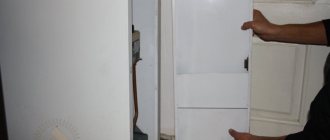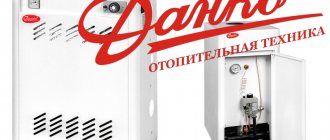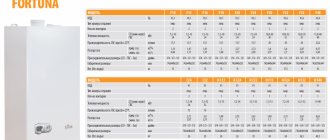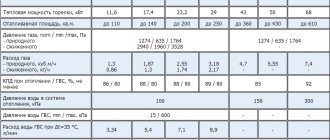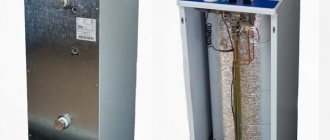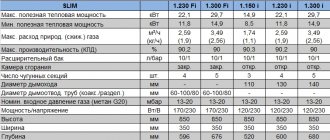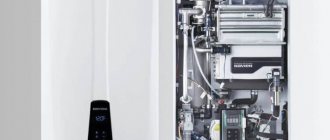Updated: 02/24/2021 13:17:21
Expert: Andrey Nikolaevich Kuznetsov
*Review of the best according to the editors of expertology.ru. About the selection criteria. This material is subjective in nature, does not constitute advertising and does not serve as a purchase guide. Before purchasing, consultation with a specialist is required.
Gas remains the most profitable and comfortable way to heat a private home in Russia. Modern gas boilers allow homeowners to carefreely enjoy warmth and comfort throughout the entire heating season. In addition, dual-circuit models also provide the household with hot water. Many users prefer floor-mounted gas boilers. Our experts will help you choose the most suitable model for your home.
Criteria for choosing a gas boiler
- One of the most important characteristics of a gas boiler is thermal power
. This value shows the maximum amount of heat that the device can produce when burning blue fuel. The power is selected taking into account the heated area. It is generally accepted that for heating 10 square meters. m requires 1 kW of thermal energy. However, this ratio is ideal, and since gas boilers have an efficiency of 90-95%, you should choose a more powerful unit (about 10-15% of the calculated value). - Floor-standing gas boilers can be single- or double-circuit.
If the house has a source of hot water or it is not needed every day, then you should give preference to single-circuit models. Otherwise, it is more profitable to take a dual-circuit device. - Many modern models must be connected not only to the gas mains, but also to a single-phase electrical network. In those populated areas where power outages often occur, it is better to install non-volatile models. The only inconvenience will be manual ignition of the burner, and the connection is made to an open-type heating system with good natural coolant circulation.
- The main part of the boiler that experiences extreme loads during operation is the heat exchanger
. The most durable products are made of cast iron. Steel analogues are susceptible to corrosion, and deformation and cracking of the walls often occur. But boilers with steel heat exchangers attract buyers due to their affordability. - Some homeowners are interested in universal gas boilers that can operate on both natural and liquefied blue fuel.
- When purchasing a gas boiler, you should pay attention to gas consumption
. Low-power models do not always outperform more efficient competitors in terms of efficiency. It should also be noted that the consumption of natural gas is indicated in cubic meters per hour, and liquefied gas in kilograms per hour. - Depending on the control method, there are gas boilers with a mechanical or electronic unit
. Mechanics are cheaper and easier to maintain, and the presence of automation allows you to set the desired air temperature in the rooms and no longer interfere with the operation of the boiler.
We have selected 11 of the best floor-standing gas boilers for our rating. All of them have passed successful tests in the homes of Russian citizens. When allocating places, the opinion of the expert community and user feedback were taken into account.
Properties of AOGV
Boilers of this type have become popular due to the fact that they have the following advantages, which were highly appreciated by consumers:
- The easy operation of this gas appliance allows you to safely and easily set the temperature within certain limits.
- The use of modern nanotechnologies in production guarantees high precision and error-free operation reliability.
- The boiler is considered non-volatile and does not require any connection to the electrical network.
- The equipment is compatible with polypropylene, cast iron, steel and other materials.
- Some models provide the ability to turn off the gas manually, which will ensure safety in an emergency or in the event of failure of automatic elements.
- The AOGV device from some manufacturers may be equipped with a circuit water heating system.
- The heat exchanger of heating devices of this type is durable and reliable.
- AOGV is not afraid of natural gas fluctuations.
- The coolant temperature can be adjusted manually.
These boilers have an optimal level of thermal protection, which ensures the most complete use of the energy of the used gas.
An attractive factor for the modern consumer, which helps to choose the right heating equipment, is environmental friendliness. Minimizing the emission of harmful substances after complete combustion of gas is due to the design of the micro-flare burner.
An important advantage is the adaptability of the gas device to the conditions of the Russian climate.
Cons of boilers
The high cost of a gas unit compared to some types of similar equipment is the main disadvantage of such a boiler. There are others:
- Certain difficulties in finding spare parts.
- Automation of outdated configurations on selected models.
- Bulky design.
- Aesthetic imperfection (the unit looks like an industrial-type device, which may not suit some users).
Rating of floor-standing gas boilers
| Nomination | place | Name of product | price |
| The best floor-standing gas boilers for heating an area up to 120 sq. m. | 1 | Vaillant atmoVIT VK INT 164/1-5 16.9 kW single-circuit | 75 720 ₽ |
| 2 | BAXI SLIM 1.300 iN 29.7 kW single-circuit | 58 510 ₽ | |
| 3 | KITURAMI STSG 13 GAS | 36 855 ₽ | |
| 4 | Protherm Volk 12 KSO 12.5 kW single-circuit | 17 029 ₽ | |
| 5 | Lemax Premium-12.5B 12.5 kW dual-circuit | 22 900 ₽ | |
| The best floor-standing gas boilers for heating an area of up to 200 - 250 sq. m. | 1 | Vaillant atmoVIT VK INT 254/1-5 25 kW single-circuit | 84 205 ₽ |
| 2 | BAXI SLIM 2.300 i 29.7 kW dual circuit | 105 584 ₽ | |
| 3 | Buderus Logano G124 WS-20 20 kW single-circuit | 89 385 ₽ | |
| 4 | Bosch Gaz 2500 F 25 25 kW single-circuit | 23 564 ₽ | |
| 5 | Protherm Bear 40 KLOM 35 kW single-circuit | 56 540 ₽ | |
| 6 | Lemax Premium-20 20 kW single-circuit | 25 050 ₽ |
Practical advice for choosing AOGV
You can choose the right boiler for your home by following the recommendations of experts:
- it is necessary to have information about the square footage and dimensions of the building or room that is planned to be heated;
- it is advisable to take into account the opinion of professionals;
- inquire about the availability of a service center that will repair the gas boiler if it fails;
- simultaneously with the boiler, you can calculate the required number of heating radiators and their installation diagram.
AOGV is the right choice for heating a large house or country estate.
Heating a house 250 m² - 87,500 rub.
Really, honestly, really
| Heating of a house 250 m² from | RUB 87,500 |
| Installation of heating boiler | 8,000 rub. |
| Installation of heating radiators (no more than 20 pcs)!!! The cost of installing a standard (mounted, not in-floor convector) heating radiator is 4,000 rubles | 45,000 rub. |
| Radiator pipe routing | 30,000 rub. |
| Pressure testing and filling with coolant | 4,500 rub. |
| TOTAL turnkey: | 87,500 rub. |
| Drilling holes, rigging, dismantling, paid extra | according to_estimate |
Heating a house 250 m² Attention. This cost is a preliminary estimate; these prices should only be used as approximate prices. The exact cost of the work is calculated after an engineer visits the work site, its complexity, and quantity.
Cost of materials from 300,000 rubles
Included by type of work
| Boiler installation | Installing an electric boiler on a wall or floor |
| Installation of pipes without “grooving” | Open pipeline installation with wall or floor mounting |
| heating radiators | Mounting the heating device on the wall, installing fasteners |
| System pressure testing | Pressure testing of the assembled system with an air compressor to identify possible leaks |
| Commissioning works | Filling with coolant (antifreeze or water), removing air from the heating system during work |
| !!! No heated floors | It is calculated additionally, it requires coordination of the type of substrate for the pipes, the type of use of the pipe, the possibility of control and automatic control, and of course the footage |
| !!! Without external chimney | To calculate the cost, an engineer’s visit is required, an inspection of the roof structure, window location and much more. |
Heating a house 250 m²
Ariston CARES X 24 FF
Having two heat exchangers, the dual-circuit Ariston CARES X 24 FF heats both the room and the water. This convection-type unit with a chimney, which is a type of turbocharged unit, is installed on the wall, so the device does not take up much space. The device is able to heat 200-250 square meters of area and runs on two types of gas: natural and liquefied. The closed combustion compartment of this flow-type boiler, combined with electronic ignition, ensures safe operation.
Advantages:
- An eight-liter expansion tank provides efficient heating.
- The efficiency reaches 93.7%, which indicates cost-effectiveness and efficiency.
- The unit can serve for a long time thanks to the stabilizing function and “anti-freeze” function that prevents damage from voltage surges.
- The device provides heating in the circuit, which is designed to supply water, up to a maximum of 60 degrees and a minimum of 36. And the heating of water in the heating pipes reaches a maximum of 82 degrees and a minimum of 35. All this ensures comfortable adjustment.
- Controlling the device and setting modes is comfortable thanks to the electronic panel with touch buttons. The screen shows data about the operation of the device.
Disadvantage - the unit is not equipped with a coaxial set, for example, Ariston 60/100-750.
Calculation taking into account the area of the room
To understand the approximate performance of a heating unit, it is important to take into account such an indicator as the area of the room. Of course, this data will not be entirely accurate, since you are not considering the height of the ceilings. For example, in central Russia, 1 kW can heat 10 square meters. meters of area. That is, if your home has an area of 160 square meters. meters, then the power of the heating boiler must be at least 16 kW.
How to include information about ceiling height or climate in this formula? This has already been taken care of by specialists who have empirically derived coefficients that allow certain adjustments to be made to the calculations.
So, the above norm is 1 kW per 10 sq. meters - implies a ceiling height of 2.7 meters. For higher ceilings, it will be necessary to calculate the correction factor and recalculate. To do this, the ceiling height must be divided by the standard 2.7 meters.
We propose to consider a specific example: the ceiling height is 3.2 meters. The calculation of the coefficient looks like this: 3.2/2.7=1.18. This figure can be rounded to 1.2. How to use the resulting figure? Let us remind you that for heating a room of 160 sq. meters you need 16 kW of power. This indicator must be multiplied by a factor of 1.2. The result is 19.2 kW (rounded to 20 kW).
Next, we should add climatic features. For Russia, certain coefficients apply depending on the location:
- in the northern regions 1.5–2.0,
- in the Moscow region 1.2–1.5,
- in the middle zone 1.0–1.2,
- in the south 0.7–0.9.
How it works? If your house is located south of Moscow (in the middle zone), then you need to use a coefficient of 1.2 (20 kW * 1.2 = 24 kW). For residents of the southern regions - for example, the Stavropol Territory - a coefficient of 0.8 is taken. Thus, heating costs become more modest (20 kW * 0.8 = 16 kW).
However, that's not all. The above values can be considered correct if a factory or home-made boiler will work exclusively for heating. Let's assume that you want to assign water heating functions to it. Then we add another 20% to the final figure. Take care of power reserves for peak temperatures in severe frosts, and this is another 10%.
You will be surprised by the results of these calculations. Let's give specific examples.
A house in central Russia with heating and hot water will require 28.8 kW (24 kW + 20%). In cold weather, another 10% of power is added 28.8 kW + 10% = 31.68 kW (rounded to 32 kW). As you can see, this last figure is 2 times higher than the original one.
Calculations for a house in the Stavropol region will be slightly different. If you add the power for water heating to the above indicators, you will get 19.2 kW (16 kW + 20%). And another 10% “reserve” for cold will give you a figure of 21.12 kW (19.2+10%). Round up to 22 kW. The difference is not so great, but, nevertheless, these indicators must be taken into account.
As you can see, when calculating the power of a heating boiler, it is very important to take into account at least one additional indicator. Please note that the formula regarding heating for an apartment and the same for a private house are different from each other. In principle, when calculating this indicator for an apartment, you can follow the same path, taking into account the coefficients that reflect each factor. However, there is an easier and faster way that will allow you to make adjustments in one go.
Calculating the power of a heating boiler for a private house and apartment will look slightly different. The coefficient for houses is 1.5. It allows you to take into account heat loss through the floor, foundation and roof. This number can be used for average wall insulation: masonry with 2 bricks, or walls made of similar materials.
For apartments this figure will be different. If there is a heated room above your apartment, then the coefficient is 0.7, if you live on the top floor, but with a heated attic - 0.9, with an unheated attic - 1.0. How to apply this information? The boiler power, which you calculated using the above formula, must be adjusted using these coefficients. This way you will receive reliable information.
Before us are the parameters of an apartment located in a city in central Russia. To calculate the volume of the boiler, we need to know the area of the apartment (65 square meters) and the height of the ceilings (3 meters).
First step: determining the power by area - 65 m2/10 m2 = 6.5 kW.
Second step: adjustment for the region - 6.5 kW * 1.2 = 7.8 kW.
Third step: the gas boiler will be used to heat water (add 25%) 7.8 kW * 1.25 = 9.75 kW.
Fourth step: adjustment for extreme cold (add 10%) - 7.95 kW*1.1=10.725 kW.
The result must be rounded, and the result will be 11 kW.
To summarize, we note that these calculations will be equally correct for any heating boilers, regardless of what type of fuel you use. Exactly the same data is relevant for an electric heating device, a gas boiler, and one that runs on liquid energy. The most important thing is the efficiency and performance of the device. Heat loss does not depend on its type.
If you are interested in how to spend less coolant, then you should pay attention to insulating your living space.
Water supply heating installation services
LLC DESIGN PRESTIGE 8(495)744-67-74
In addition to fast and high-quality repair of heating pipes, we provide professional installation of turnkey heating systems. On our heating page > resant.ru/otoplenie-doma < you can view and get acquainted with examples of our work. But to be more precise, it is better to check with an engineer about the cost of work and equipment.
To contact us, use the contact number of DESIGN PRESTIGE LLC 8(495) 744-67-74 , which you can call around the clock.
Heating from DESIGN PRESTIGE LLC Type: water here > /otoplenie-dachi.html
note
Our company DESIGN PRESTIGE LLC is part of the non-profit organization ANO INTERREGIONAL BOARD OF FORENSIC EXPERTS. We also provide independent construction technical expertise services.
Ferroli Domina F 24 N
Ferroli Domina F 24 N attracts with its sophisticated design with smooth lines. This device is double-circuit, so it not only supplies heating, but also heats water.
Made of copper, the heat exchanger is coated with a special alloy containing aluminum, which protects it from corrosion. The steel combustion chamber is also protected with the same anti-corrosion coating. All this adds years of service life to the device.
Advantages:
- The ignition is not equipped with an igniter, but is powered by electricity, which, in combination with ionization electrodes, ensures safe use.
- Thanks to a technique that prevents blocking of the pump installed in the circuit intended for heating operation, the unit does not stop supplying heat: as soon as a day passes, the pump starts, even if the boiler is inactive.
- Even if the device is turned off, it will not freeze thanks to the technology that prevents this: go on vacation calmly, leave the dacha in the cold - the device will not break.
- The device is compatible not only with natural gas, but also with liquefied gas, which expands its operational capabilities. Remember: to work with liquefied gas, a special kit is required.
- Thanks to the efficiency of over 90%, fuel savings are achieved.
- In addition to the fact that the device is equipped with a microprocessor and is controlled using an electronic panel, the user has the opportunity to connect a remote system and control the device with a remote control.
- Easy to maintain: the “filling” of the boiler is located so that it becomes accessible from its front part.
- The device self-diagnoses, which increases the safety of use: in the event of a malfunction, the corresponding error code is displayed on the display. The LED screen also shows the set climate mode.
Disadvantage: this boiler has mechanical control levers, which reduces the accuracy of determining the temperature regime.
Interesting to know: How to choose an oil heater?
Nuances of maintenance and connection
Now, as before, installing a gas heating boiler is not an easy task. To install such equipment you will need:
- coordinate actions with Gostekhnadzor;
- draw up a boiler connection project;
- prepare the room, connect the chimney, ensure the main gas supply to the boiler.
A number of norms and rules have been developed that will have to be followed during installation:
- you will need a ventilated room for installing the boiler, with access to the street;
- the area of the room must be at least 100 m²;
- It is mandatory to install an automatic system that is responsible for gas leaks.
Gas boilers of the old type were connected to chimneys at least 5 m long, only with natural draft. These requirements were mandatory and contributed to minimal formation of condensation - the main drawback of retro devices.
Now coaxial chimneys and circulation pumps are used, so it is possible to provide forced draft and install the chimney through a wall or into a ventilation shaft, which makes installation easier and makes the chimney connection area neater. The photo shows the correct installation of the boiler.
Wall mounted boiler
The market now offers installation components and care products that extend the life of devices and increase operating efficiency.
The compact design of the new heating devices and light weight, which are especially distinguished by wall-mounted gas models, allow the device to be installed in a matter of hours, as shown in the video below, and used even in small rooms.
Principle of operation
In order to ensure high-quality heating of the coolant with automatic regulation and safe operation of the equipment, the following structural elements are installed:
- A magnetic valve that shuts off gas to the burner when the torch breaks or the draft decreases below the minimum parameters established by the passport data.
- Two-position thermostat (on/off) for automatically maintaining the set temperature of hot water in a pipe heat exchanger, transmitting a signal to the gas burner, with temperature adjustment in the range from 50 to 90 C.
- Traction sensor with signal transmission to igniters and shut-off magnetic valve.
- Fittings for connecting coolant and two outlets for hot water supply and heating.
- A cylindrical tank is connected to an in-house pipe system with internal heat exchangers, which increases the efficiency of the installation.
The house system consists of: supply and return pipelines, heating radiators, expansion tank, shut-off and control valves. Under the influence of natural circulation, water enters the device from the return pipeline, where it is heated by fuel combustion products and passes into heat exchangers for heating and hot water supply, cools, transferring heat to the external circuit, and then returns through the return pipeline to the unit.
AGV design
The AOGV gas boiler has a gas-tube design with a vertical flame tube and is installed on the floor. The round burner is located at the bottom. The air required for combustion enters through the lower holes in the casing. Removal of combustion products occurs naturally, through the chimney pipe at the top, at the base of which there is a draft breaker cap with a door.
Design of the AGV-80 gas unit
The flame tube is divided into sections by so-called turbulators, which provoke turbulence in the flow of exhaust gases, reduce its speed and increase the efficiency of the device.
The connection pipe for the direct line of the heating system is mounted on the top cover of the boiler. Returns are on the side. The AGV-80 gas boiler differs from the AGV-120 in that the fuel line with shut-off valves is located on the outside and does not have a casing.
In combined models (with the letter “K”) there is a coil that wraps around the flame tube from the inside. It supplies hot water to the water supply system.
The boiler automation stops the gas supply in three cases:
- When traction drops.
- Pressure drop in the fuel line.
- Flame breakout or arbitrary cessation of combustion.
No connection to electrical networks is required, the device is completely autonomous. The boiler casing is made round or square, which depends on the type of design - “Economy”, “Universal” or “Comfort”.
Design of the AGV-120 gas unit
Device and technical characteristics
In the Russian Federation, the main suppliers of AOGV are the Borinsky and Zhukovsky plants; for the same power, the technical characteristics of the units are almost the same.
The Borinsky plant produces a line of heaters with a power from 7 to 29 kW in two versions - single-circuit and combined, which makes it possible to economically heat houses with an area of up to 100 m2.
Design of Borino boilers AOGV 29:
- Open combustion chamber with air intake from the room.
- The installation scheme has the ability for natural and forced ventilation.
- In buildings where it is technically impossible to organize good air exchange, you can install an electric fan.
- In the upper part of the firebox above the burner there is a jacket with coolant.
- The device is equipped with separate heat exchangers for heating and hot water.
- A safety system that turns off the boiler with a sensor in the form of a copper thermocouple works in tandem with an electromagnetic valve that cuts off the gas if the torch goes out.
Protherm Cheetah 23 MTV
Having two circuits, Protherm Cheetah 23 MTV will not only heat 230 square meters of room, but also heat the water. Thanks to the display, operation is controlled by the owner. A five-liter flow-through convection unit is mounted on the wall, so it does not clutter up the room.
Advantages:
- It runs on two types of gas: liquefied and natural.
- Electronic ignition ensures safe use.
- Thanks to the ventilation burner, combustion products are discharged into the air duct. This guarantees safe use and clean air.
- The heat exchanger, made of stainless steel, is not susceptible to corrosion or mechanical damage.
- Monitor the operating condition and find faults in time using the installed diagnostic system.
- Thanks to the three-mode temperature, the user has the opportunity to choose an option for winter, autumn-spring and vacation. In “vacation” mode, the device operates at minimum power levels, which prevents the apartment from cooling down, but also does not waste fuel.
- The “antifreeze” function, which prevents the boiler from freezing, is always on.
- The device also has a feature that prevents the pump or three-way valve from getting stuck.
- The power of the device is adjustable, which allows you to save money. At the same time, the efficiency level is 92%.
- Use the device comfortably at any time of the year: the temperature conditions of water and heating are regulated separately.
- Operate the unit comfortably with electronic buttons and indicators displayed on the screen. It is possible to control the device using a thermostat.
- The device displays the water pressure level and is also equipped with a tap designed to drain it.
Despite all the advantages, the boiler has a drawback - it cannot be controlled from a distance.
Advice: if the dacha is disconnected from gas, heat it using a solid fuel option.
Features of operation
The boiler was produced, naturally, at factories in the USSR, made from domestic raw materials and equipped with locally produced electronics. The quality of workmanship was at a high level, but the automation failed in the vast majority of cases already in the first heating season. But the equipment worked perfectly without it, so no one paid attention to such a defect.
But the boiler was reliable and durable in all other respects. The level of gas consumption was indeed incredibly low, although the efficiency barely reached 70%, which is an extremely low figure for gas installations. But still, for private houses this was the only way to heat a home using a modern unit, and not an old wood- or coal-burning stove. And in multi-storey buildings, such a boiler made it possible to improve living conditions, since residents could regulate the temperature of the interior themselves.
The factory glass thermometer also quickly failed and had to be replaced with a higher quality product. But for repairs it was possible to use parts from any other equipment. The main thing is that the size and shape are suitable, and craftsmen can figure out how to fit them in place without any problems. In general, the model had an incredible number of user modifications.
